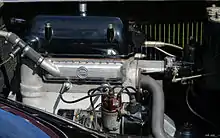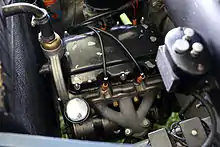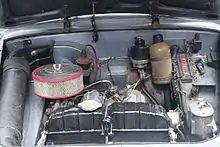Lancia V4 engine
Italian automobile company Lancia was the first to manufacture cars with V4 and V6 engines in series-production. This started with a number of V4-engine families, that were produced from the 1920s through 1970s.
| Lancia V4 engine | |
|---|---|
 In Lancia's Fulvia model, the 1.3 litre V4 engine was mounted at a 45° angle. | |
| Overview | |
| Manufacturer | Lancia |
| Production | 1922-1976 |
| Layout | |
| Configuration | All V4s at: 10°, 11°, 13°, 20° |
| Displacement |
|
| Cylinder bore |
|
| Piston stroke |
|
| Head material | Aluminum |
| Valvetrain | SOHC or DOHC |
| Compression ratio | 9.0:1 |
| Combustion | |
| Fuel system | Carburetor |
| Fuel type | Gasoline |
| Oil system | Wet sump |
| Cooling system | Water-cooled |
| Output | |
| Power output | 28–132 hp (21–98 kW; 28–134 PS) |
| Chronology | |
| Successor | Lancia Flat-4 engine |
The Lancia V4 pioneered the narrow-angle V engine design, more recently seen in Volkswagen's VR5 and VR6 engines. By using very shallow V-angles — between 10° and 20° — both rows of cylinders could be housed in an engine block with a single cylinder head, like a straight engine.
A determining characteristic was the use of overhead camshafts (either single or double), in which a camshaft would serve the same function for all cylinders — in both cylinder banks.
Lambda

The first V4 was used in the Lambda from 1922 through 1931. It was a 20° narrow-angle aluminum design. All three engine displacements shared the same long 120 mm (4.72 in) stroke, and all were SOHC designs with a single camshaft serving both banks of cylinders.
Engines:
- 2.1 L; 129.3 cu in (2,119 cc) 75 mm (2.95 in), 49 hp (37 kW; 50 PS) at 3250 rpm
- 2.4 L; 144.6 cu in (2,370 cc) 79.37 mm (3.12 in), 59 hp (44 kW; 60 PS) at 3250 rpm
- 2.6 L; 156.7 cu in (2,568 cc) 82.55 mm (3.25 in), 69 hp (51 kW; 70 PS) at 3500 rpm
Artena
The Lambda engine was updated for the Artena. Bore was set at 82.55 mm (3.25 in) as in the 2.6 L Lambda, but stroke was reduced to a more conventional 90 mm (3.54 in). Total displacement was 1.9 L; 117.6 cu in (1,927 cc), with 55 hp (41 kW; 56 PS) produced at 4000 rpm.
Augusta
An all-new V4 was designed for the Augusta. Produced from 1934 through 1938, the Augusta's engine displaced just 1.2 L; 73.0 cu in (1,196 cc) with a 69.85 mm × 78 mm (2.75 in × 3.07 in) bore and stroke. Power output was 35 hp (26 kW; 35 PS) at 4000 rpm.
Aprilia
The engine was redesigned again for 1936's Aprilia. The first-series cars used a 1.4 L; 82.5 cu in (1,352 cc) version with a 72 mm × 82 mm (2.83 in × 3.23 in) bore and stroke. Output was 47 hp (35 kW; 48 PS) at 4300 rpm.
A second series was unveiled for 1939 with an enlarged 1.5 L; 90.7 cu in (1,486 cc) engine. It did not share its predecessor's dimensions, with bore and stroke now at 74.61 mm × 85 mm (2.94 in × 3.35 in). Power output was nearly the same at 48 hp (36 kW; 49 PS).
Ardea

A small V4 (tipo 100) powered the compact 1939 Ardea. It was a 20° narrow-angle engine displacing just 0.9 L; 55.1 cu in (903 cc). Bore and stroke were new again at 65 mm × 68 mm (2.56 in × 2.68 in), and output was just 28.8 PS (21.2 kW; 28.4 hp) at 4600 rpm. For the 1949 tipo 100B power was increased to 30 PS (22 kW; 30 hp).
Appia

The V4 returned after the war with the 1953 Appia. It featured an even narrower 10° cylinder bank and just 1.1 L; 66.5 cu in (1,090 cc) of displacement, fitting below Italy's 1.1-liter tax threshold. An initial 38 hp (28 kW; 39 PS) of power grew to 43 hp (32 kW; 44 PS) in 1956. 48 hp (36 kW; 49 PS) was available in 1959.
Fulvia
Lancia's final V4 series were used in the Fulvia, remaining in production up until 1976. Designed by Zaccone Mina, it used a narrow angle (13°) and was mounted well forward at a 45° angle. The engine was a true DOHC design with one camshaft operating all intake valves and another operating all exhaust valves.
Displacement began at just 1.1 L; 66.6 cu in (1,091 cc) with 59 hp (44 kW; 60 PS) with a 72 mm × 67 mm (2.83 in × 2.64 in) bore and stroke. A higher (9.0:1) compression ratio raised power to 71 hp (53 kW; 72 PS) soon after.
The engine was bored to 76 mm (2.99 in) to enlarge engine displacement to 1.2 L; 74.2 cu in (1,216 cc) for the Coupé model. This, and some tuning, raised output to 80 hp (60 kW; 81 PS), further enhanced up to 88 hp (66 kW; 89 PS) for the HF model.
The engine was re-engineered with a slightly narrower bank angle and longer 69.7 mm (2.74 in) stroke for 1967. Three displacements were produced: 1.2 L; 73.2 cu in (1,199 cc) 74 mm (2.91 in) bore, 1.2 L; 75.1 cu in (1,231 cc) 75 mm (2.95 in) bore, and 1.3 L; 79.2 cu in (1,298 cc) 77 mm (3.03 in) bore. The latter engine is most common, with the first unit only sold in Greece. Three levels of performance were available: 87 hp (65 kW; 88 PS) for common 1.3 Liter (commonly imported in USA and described as "highly tuned" by Road & Track at the time); 90 hp (67 kW; 91 PS) for its 1.3s evolution and 101 hp (75 kW; 102 PS) for the Rallye HF.
The engine was redone again for a new HF with an even narrower 11° cylinder bank and longer 75 mm (2.95 in) stroke for its final incarnation. A bore of 82 mm (3.23 in) gave it a displacement of 1.6 L; 96.7 cu in (1,584 cc), and power shot up to 114 to 132 hp (85 to 98 kW; 116 to 134 PS) depending on tune.
See also
- Volkswagen VR6 engine, for a more technically detailed article about narrow-angle V-engines
External links
| Wikimedia Commons has media related to Lancia V4 engine. |
- Lancisti.net - An Information Exchange and Support Community for Lancia Owners and Enthusiasts
- "All about Lancia Fulvia". Fulvia Site. Archived from the original on March 7, 2005. Retrieved March 10, 2005.
- James T. Crowe (ed) (1968). "Toyota 2000 GT". Road & Track Road Test Annual: 110–113.CS1 maint: extra text: authors list (link)